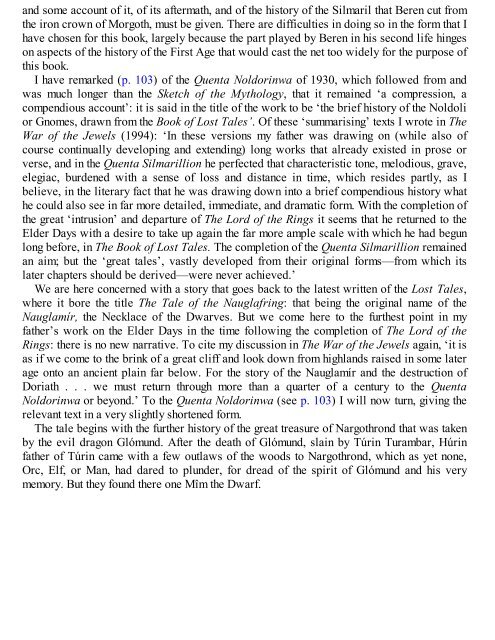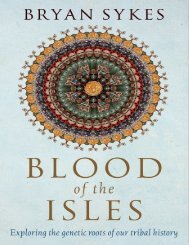Create successful ePaper yourself
Turn your PDF publications into a flip-book with our unique Google optimized e-Paper software.
and some account of it, of its aftermath, and of the history of the Silmaril that Beren cut from<br />
the iron crown of Morgoth, must be given. There are difficulties in doing so in the form that I<br />
have chosen for this book, largely because the part played by Beren in his second life hinges<br />
on aspects of the history of the First Age that would cast the net too widely for the purpose of<br />
this book.<br />
I have remarked (p. 103) of the Quenta Noldorinwa of 1930, which followed from and<br />
was much longer than the Sketch of the Mythology, that it remained ‘a compression, a<br />
compendious account’: it is said in the title of the work to be ‘the brief history of the Noldoli<br />
or Gnomes, drawn from the Book of Lost Tales’. Of these ‘summarising’ texts I wrote in The<br />
War of the Jewels (1994): ‘In these versions my father was drawing on (while also of<br />
course continually developing and extending) long works that already existed in prose or<br />
verse, and in the Quenta Silmarillion he perfected that characteristic tone, melodious, grave,<br />
elegiac, burdened with a sense of loss and distance in time, which resides partly, as I<br />
believe, in the literary fact that he was drawing down into a brief compendious history what<br />
he could also see in far more detailed, immediate, and dramatic form. With the completion of<br />
the great ‘intrusion’ and departure of The Lord of the Rings it seems that he returned to the<br />
Elder Days with a desire to take up again the far more ample scale with which he had begun<br />
long before, in The Book of Lost Tales. The completion of the Quenta Silmarillion remained<br />
an aim; but the ‘great tales’, vastly developed from their original forms—from which its<br />
later chapters should be derived—were never achieved.’<br />
We are here concerned with a story that goes back to the latest written of the Lost Tales,<br />
where it bore the title The Tale of the Nauglafring: that being the original name of the<br />
Nauglamír, the Necklace of the Dwarves. But we come here to the furthest point in my<br />
father’s work on the Elder Days in the time following the completion of The Lord of the<br />
Rings: there is no new narrative. To cite my discussion in The War of the Jewels again, ‘it is<br />
as if we come to the brink of a great cliff and look down from highlands raised in some later<br />
age onto an ancient plain far below. For the story of the Nauglamír and the destruction of<br />
Doriath . . . we must return through more than a quarter of a century to the Quenta<br />
Noldorinwa or beyond.’ To the Quenta Noldorinwa (see p. 103) I will now turn, giving the<br />
relevant text in a very slightly shortened form.<br />
The tale begins with the further history of the great treasure of Nargothrond that was taken<br />
by the evil dragon Glómund. After the death of Glómund, slain by Túrin Turambar, Húrin<br />
father of Túrin came with a few outlaws of the woods to Nargothrond, which as yet none,<br />
Orc, Elf, or Man, had dared to plunder, for dread of the spirit of Glómund and his very<br />
memory. But they found there one Mîm the Dwarf.
















